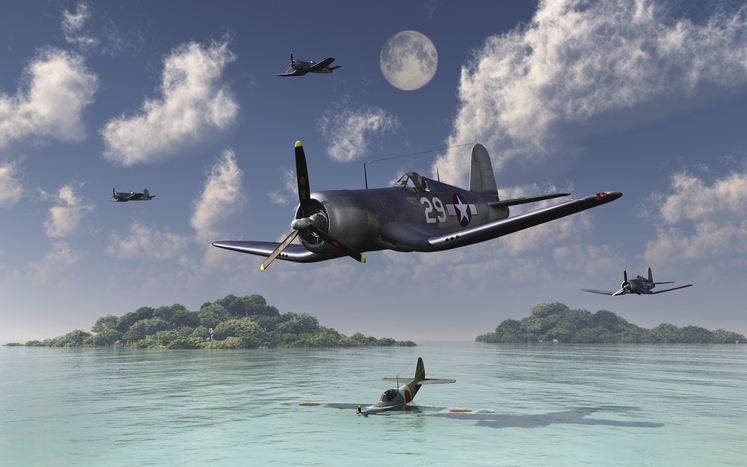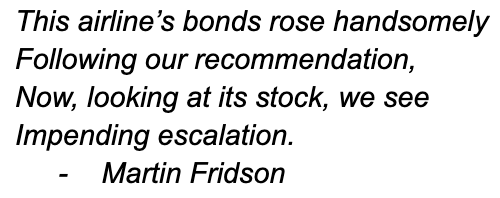
A Few Factors Drive This Airliner’s Shares Higher
After A Failed Merger, A Path To Profitability
| Welcome to Porter & Co. Distressed Investing, edited by Wall Street’s Dean of High Yield, Martin Fridson. To learn how distressed investments like this one help us take advantage of “The Greatest Legal Transfer of Wealth in History,” see the complete Guide to Distressed Investing on our Reports page. In addition to hosting Distressed Investing on our website, we also make it available as a downloadable PDF on the Issues & Updates page here. |

May 10, 1945. Clear skies at an altitude of 38,000 feet – and a hostile Japanese fighter plane at 11 o’clock.
It was a bad time for Captain Kenneth Reusser to run out of ammo.
Reusser had started the mission with a full feed belt. But he and his wingman, Lieutenant Robert Klingman – both piloting hefty F4U Corsairs – purposely ditched half their bullets to gain altitude, after spotting telltale vapor trails from enemy planes high over the Japanese island of Okinawa.
Reusser’s first salvo took out part of the enemy plane’s right wing and a chunk of its engine. A wound, but not a deadly one. Then Reusser’s underfed Browning machine gun – standard kit for the Corsair – sputtered to a halt.
Klingman, the wingman, swooped in to provide backup. But at just 50 feet away from the Japanese plane, the glacial high-altitude temperature froze the firing mechanism on his own machine gun.
Two neutered Corsairs and one hornet-angry Kawasaki fighter… if anyone ever needed an ace in the hole, the Americans did now.
Fortunately for Klingman, he had a secret weapon: the Wasp.
The 2,000-horsepower Double Wasp 18-cylinder engine – the first one capable of pushing a fighter plane over 400 miles per hour – was the heart and soul of every Corsair. And it spun the plane’s propeller a dizzying 2,700 times every minute.
Klingman might not have had a working gun, but he sure as hell had working turbo-props.
As the enemy opened fire at point-blank range, Lt. Klingman dove toward the Kawasaki and – channeling the bronze battering rams on ancient warships – aimed his four-blade propeller at the enemy’s undercarriage.
Buzz. Buzz.
First he pulverized the rudder… then, the right stabilizer. Within moments, the off-balance Japanese plane tacked into a sharp tailspin and plunged downward. At 15,000 feet, both wings snapped off. For the Japanese pilot – who didn’t seem to have packed parachutes – there was no cushy landing.

For Klingman, who landed his own plane safely despite severe damage, there was a Navy Cross and an Air Medal. And for the Wasp-powered Corsair, there was another legend to add to its already-storied wartime résumé – including an unmatched 11-to-1 kill ratio (11 enemy deaths for every Allied casualty) spread across the 12,000 Corsairs used by Allied forces during World War II. By the end of the conflict, Corsair pilots had flown over 64,000 missions and taken out 2,000 enemy planes… while losing only 189 of their own.
The Corsair legacy didn’t stop with World War II, either – it was the only make of WWII plane still manufactured for post-war (and, eventually, Korean War) duty, with the last active Corsair finally decommissioned in 1970. (In 1976, the plane even inspired its own TV show, Black Sheep Squadron, the semi-historical adventures of a squadron of misfit Corsair pilots in the U.S. Marines.)
The Corsairs – and the fearless men who flew them – carved out an enduring spot in American folklore. It’s a niche they’d never have achieved without the throbbing heart of the Corsair… the supercharged Wasp engine.
This is the story of the Wasp… and, unfortunately, the story of its maker’s steep and strange nosedive…
Jet Lag
In 1925, Connecticut aviation engineer Frederick Rentschler founded the Pratt & Whitney Aircraft Company (“P&W”), headquartered in (and named after) a local tool factory called Pratt & Whitney. Rentschler’s goal was to build a 400-horsepower engine weighing under 650 pounds. It was a challenge the U.S. Navy had issued to plenty of other manufacturers… and up until then, no one had cracked the code.
Until the Pratt & Whitney Wasp debuted in 1926, that is.
Thanks to its featherweight, air-cooled design (a far cry from earlier water-cooled models with their heavy plumbing) Rentschler’s Wasp was able to climb higher, push planes faster, and notch world records for famed flyers like Charles Lindbergh and Amelia Earhart (and, eventually, serve as the engine of choice for WWII’s most iconic airship, as well as many others).
Impressed with Renstchler’s 1926 prototype, the Navy ordered a batch of 200 – and, to quote Humphrey Bogart’s character in the film Casablanca, it was “the beginning of a beautiful friendship.”
Over the next several decades, the Wasp (along with its ever higher-powered variants, the Twin Wasp, the Double Wasp, and the Wasp Major, with nine times the horsepower of the original Wasp) propelled P&W from a warehouse startup to a global engine manufacturer. By the end of World War II, a 40,000-man workforce was churning out half of the engines needed to power the Allied effort – with automakers Ford, Buick, and Chevrolet subcontracting to make even more engines according to P&W specs.
Of course, by then, the mergers had begun. In 1929, taking the Pratt & Whitney name and techniques with him, Rentschler joined the United Aircraft and Transport Corporation. That firm spun off into a series of smaller companies (United Aircraft Corporation, United Technologies, and Boeing, among others) before merging with electronics giant Raytheon in 2020, all the while maintaining P&W as a distinct brand.
And somewhere in there, the creators of the Wasp lost their sting.
First of all, Pratt & Whitney was late to the jet party: its WWII-era Wasp prop technology was so iconic that it didn’t start producing new-fangled jet engines until the 1950s, well after competitors General Electric (“GE”) and Westinghouse got a head start. The lag continued: in the 1980s, Pratt & Whitney succumbed to what Forbes magazine describes as a “slow fade to third in the passenger jet market,” behind Rolls Royce and GE. By the late 2000s, GE was cranking out 1,000 jet engines a year to Pratt’s 200. Then, in 2015, the company made a daring bid to reclaim jet-engine market share… but it was a gamble with mixed results.
That year, P&W engineers developed an innovative geared turbofan jet engine… pre-sold it to four major airlines… and then realized that it couldn’t deliver. Not by the 2018 deadline, anyway. Pratt’s factories were outdated and not outfitted to handle a backlog of orders – and a problem with faulty seals led to a four-week factory shutdown and some very angry clients.
That was just the start of P&W’s turbofan woes. In August 2023, Pratt had to recall 1,200 of the engines due to microscopic cracks in their powdered metal – grounding planes from 57 different airlines during peak summer travel months. (One Indian airline sued the engine maker after being forced into bankruptcy due to the faulty engine.) Between 2022 and 2023 P&W sales plunged from $20.5 billion to $18.3 billion.
It’s possible that P&W engineers only had one truly great idea in them… the peerless WWII-era Wasp. Luckily for them, they’ve already left an indelible mark on history, one that won’t be easily erased by jet-age failures.
It’s Pratt & Whitney’s powdered metal debacle – along with a few other snafus – that’s depressed the airline company we are recommending in this issue. Pratt & Whitney, you might say, has temporarily grounded this company’s shares – but likely not for long, as we’ll explain.
This content is only available for paid members.
If you are interested in joining Porter & Co. either click the button below now or call our Customer Care Concierge, Lance James, at 888-610-8895.